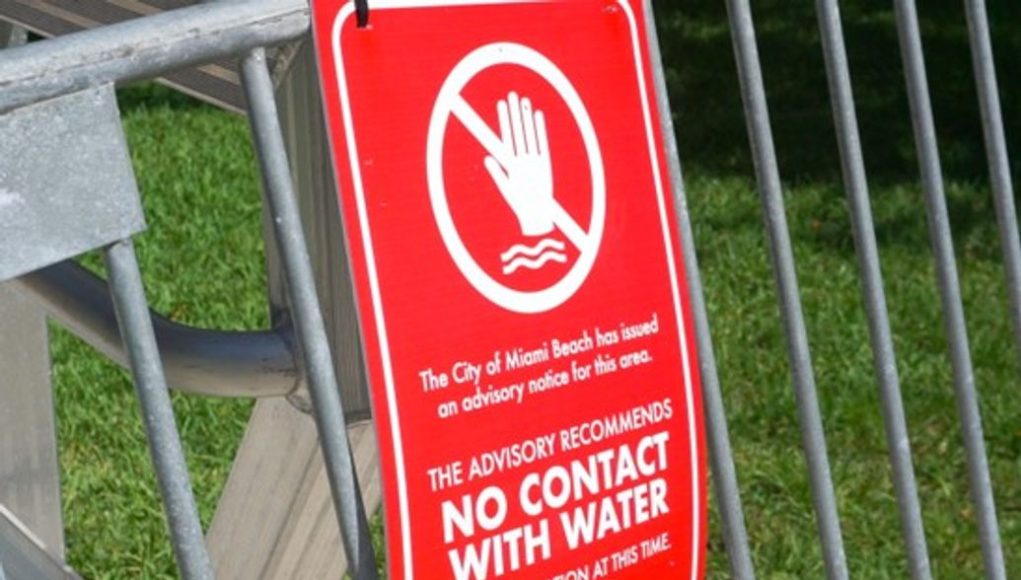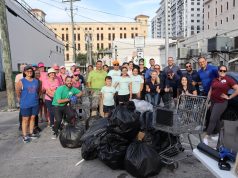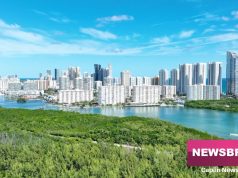Para leer este artículo en español, haga clic en este enlace.
“I love living here, it’s quiet, I have no complaints,” said Elena Barrios, who has lived on Park View Island, north of Miami Beach, for nearly three decades.
Between the comings and goings of this hard-working neighborhood, only a few realize that the canals surrounding it, are pure contamination. With pollution so high, the only access ramp to the public and Biscayne Bay, has been closed for more than two years.
City officials are trying to identify the problem. “We’ve had city staff meetings with managers and assistants and they’re trying, it’s just not their top priority,” said Park View resident Tanya Bhatt.
SFMN got the first results of DNA water testing, conducted by Surfrider this July, when bacteria levels reached the levels of the most contaminated “beaches,” or aquatic recreation sites, in the entire nation.

SFMN also sent seven interview requests over the past two months to city officials, without receiving a response prior to the publication of the report.
One of the findings of the DNA analysis is that the enterococcus, the contaminating bacteria, came mostly from human fecal waste, indicating a problem in wastewater management.
The investigation was made possible by the efforts of half a dozen residents who decided to join forces and confront what they consider to be slowness and negligence on the part of the City of Miami Beach and the Florida Department of the Environment regarding the relentless contamination of the waters of the Park View Island canal.
An anonymous neighbor on the island contributed financially to the weekly water testing, which led Blue Task Force, a laboratory of the Surfrider Foundation, to study the quality of the canal, Bhatt explains. Since 2020, they have been conducting the weekly tests, every Thursday.
A year and a half ago, Park View Island resident Omar Jimenez created the Park View Sustainable Association: “It’s a shared desire of the community. Our hope is that the city will get this issue under control and give us back our diminished quality of life,” said Jimenez.

“We want to use these waters for recreational purposes and enjoy the homes for which we pay high property taxes,” said Jimenez who remembers seeing the animals and enjoying the clarity of the canal waters that surround him when he arrived in 2018.
Another initiative of the association has been an annual cleanup of the canals in which it has already collected more than 400 pounds of trash. ”We have to come together to solve the crisis of this paradise,” adds Jimenez.
It Continues to be Miami’s Dirty Little Secret
After closing the kayak ramp more than two years ago, the city ordered water quality testing by a local contractor, then claimed the contamination came from pet waste. The solution was to launch a program to educate the public about the responsibilities of picking up pet feces.
“We said that was nonsense,” said Bhatt, believing that island residents had always done a good job of cleaning up after their pets.
Following those results, the city added dog waste stations along sidewalks and grass.

DNA testing, conducted by the Blue Water Task Force, shows that while animal contamination exists, most of the bacteria came from human feces.
SFMN asked Stripling if he believed there was a link between possible sewage leaks and high bacteria levels: “Absolutely. Absolutely. That’s probably the source that’s leaking into that general area.”
As the evidence reveals, contamination in the island’s waterways continues to reach stratospheric levels periodically. For example, on July 7, 24,000 enterococcus colony units (ECU) per 100 milliliters of water were recorded. This exceeds more than 300 times the state limit. The Florida Department of Health alerts, for closures of beaches or water access when levels exceed 70 ECU per 100 ml.
“We’re getting very high levels of contamination,” said Scott Stripling.

Enterococcus is a bacterium found in the intestinal lining of animals and humans.
Although the latest DNA tests point mostly to human waste and thus to an unidentified sewage spill or leak, there are other factors that can affect the quality of Park View Island’s water, scientists say.
Days before the July 7 reading of more than 24,000 UECs per 100 ml, there had been heavy rainfall in the city of Miami Beach. “Extreme weather events may contribute to the high bacteria levels reported, especially in slow-moving coastal areas like Park View,” said Stripling.

The area of the channel where the kayaks are launched is very isolated from the waterways and open to the sea and this does not allow currents to pass easily. This means that the dirt that gets there is trapped for a longer period of time.
“Flash floods increase waste transport to receiving water bodies like rivers, lakes and others and can deteriorate the water quality,” said Dr. Assefa Melesse, professor of Land and Environmental Water Resources Engineering at FIU. In addition, if floods are flash floods, they increase the transport of waste, such as raw sewage into waterways.
Dr. Melesse said the relationship with climate can be seen if the frequency and intensity of rainfall is related to climate change and that indirectly impacts water quality through flooding.
Another factor to consider in pollution is the decay of human fecal bacteria that seep through sewage pipes. When they spend a long time in the canal, identifiable components change and continue to multiply if they encounter a favorable environment.
Stripling said it is now key to identify where the bacteria are leaking from, and how to clean up those that are already endemic.
“Enterococcus bacteria can survive in the environment, if the water conditions are warm enough and just right,” he said. Marine biologists in Miami say they can live there if there is also organic matter, as in Park View,” said Stripling.
How are the tests done?
The water tests, which are done every Thursday, begin with the collection of a water sample at Island Park’s public kayak access ramp. After the water is tested, the samples are distributed in a quanti-tray (pictured below), sealed, and placed in an incubator. All that remains is to wait 24 hours for the bacteria results.

Clear = Low contamination (left), Blue = High contamination (right).
Stripling explains that contamination can be verified by applying blue light to the test results. When samples appear clear (left side of photo), the sample has no bacteria or is below the risk level. High levels of bacteria appear blue, such as the samples in the upper right.
The Problem: It’s more than just the sewage leak that happened 2 years ago
After 2 years, 4 months and 28 days without identifying the source of canal pollution, pollution spikes are not a surprise, but the norm.
“We are the only area in the city that is consistently in the red zone, ” assures Bhatt.
The city of Miami Beach claims to have invested more than $70,000 in efforts such as blowing smoke through pipes to find leaks, video surveillance, water quality sampling, hiring a group to conduct an investigation and cleaning the sewer system.
“It’s not that the city hasn’t done anything. It just hasn’t been their top priority,” Bhatt repeats.
In fact, bacteria levels measured here exceeded health standards 83% of the time they were tested last year. This resulted in a report recently published by Surfrider that listed the Bay’s public access water recreation area, Park View, as one of the beaches, or water recreation areas, with the highest levels of bacteria contaminants in the U.S.

The problem was discovered after an accident in 2019, where two contractors, AC. Schultes and Calea Corporation drilled a 42-inch sewer pipe near Lincoln Road.
“Since then, we’ve had the warning to avoid contact with the water,” said Bhatt.
The Florida Department of Environmental Protection sued the city and contractors on November 2, 2020, for violating the Clean Water Act.
After the back and forth of the case, a Miami-Dade Circuit Court judge closed the case on Jan. 14, 2022. Judge Beatriz Butchko fined well-extraction companies $65,000 for releasing 1.6 million gallons of dirty water on Miami Beach.
In a final settlement, the city agreed in court to develop a plan for dealing with similar contamination and submit it to the Florida Department of Environmental Protection.
SFMN reviewed the Sanitary Sewer Overflow Response Plan, which the city submitted a month ago. It includes how to inform internally and the public, how to assess water quality in the event of a pipe rupture, or sewer overflow, and the process of estimating spill volume, containment and cleanup.
But it does not cover what to do in the face of periodic contamination of a canal such as on Park View Island, when scientific research reinforces the theory that, in addition to unidentified sewage losses or leaks, there is endemic contamination.
“I don’t know if there is a resolution in the short term. But it’s a process and a procedure,” said Stripling. “It’s also important to look at the infrastructure there and identify where it might be leaking from. Take a look at that, underneath the body of water.”
The Problem and its Consequences
“It caused an abscess on my skin due to a toxic algae,” Jimenez assures. “After two and then three weeks, it only got worse.”
Jimenez said his infection occurred around the time he was enjoying his free time in the water, before he knew it was contaminated.
“I had to be on experimental antibiotic treatment to get rid of that bacteria,” said Jimenez.
His doctors said his condition may have occurred when a wound came in contact with high levels of bacteria in the water. The infection left him with a scar. Stirpling affirmed the effects of the bacteria.
Doctors at Memorial Regional in Pembroke Pines confirmed that high levels of the bacteria can also cause these infections. In addition, “Enterococcus causes diarrhea and discomfort, as well as gurgling,” said Dr. Ronoel Penalver, MD.
Valentina Palma, who also who moved to Park View Island just a couple of months ago, told SFMN that she used the waters hours before her interview.
“There are no signs, no signs warning about contamination,” Palma said. “And I had no idea. There must be a way to tell the public which waters are contaminated. People don’t know.”
Bhatt and Jimenez worry about future generations, including a nearby school.
“On high tide days, the water at Crab Island reaches both the parking lot and the playground at Biscayne Bay Elementary School,” said Bhatt. “Which can endanger the health of the children.”
Future of the Island
“The manatees would wander everywhere in the waters. You would give them some lettuce and they would follow you. Now I see them once every six months. And then they turn around and leave. It’s like they know what’s going on,” said long-time resident, Frank Lucientes, who has been living on the island for decades.
“I don’t really recognize the canal water from when I first moved here,” said Jimenez as the water is noticeably dark. “The opportunity to live by the canal was one of the reasons I bought land here.”
Tanya Bhatt who is also a resident, but since 2018, said that it a significant change.
“I have all kinds of images of fish swimming in circles and chasing each other. The manta rays and manatees with their new babies. And you could see all the way to the bottom of the water. And not anymore, it smells horrible.” said Bhatt.


Bhatt tells us that Miami Beach city staff has been intentional about improving this issue. A commissioner, who since then has passed away, brought attention to the problem and elevated its importance.
According to an article published by the Miami Herald, the City of Miami Beach is reaching out to experts to try to find short-term solutions for our environmental ecosystem.
Despite health concerns about the pollution it has caused, residents are paying high prices on rent and are unable to make use of the water.
“How unfortunate not to be able to use the water and have it right here. But you can tell the water is filthy,” said Palma.
Stripling suggests that the city of Miami Beach take a look at the infrastructure to find the source of the leaks.
His next strategy is to test the water from different areas of the park’s view canal and clarify whether sewage leaks are still responsible for the high level of contamination.
The question many residents have for the city is how the pollution can be eliminated. Surfrider environmentalists say that conducting air or water blasts can help get new fresh water into the canal. Until the city of Miami Beach reacts.
Bhatt suggests that the city of Miami Beach form relationships with experts nationally or internationally.
“I want our staff to get in touch with people who are dealing with these problems around the world,” suggested Bhatt. “We need to expedite research and identify resources within our budget and fix this. New developments and thousands of units are coming.”
As developments increase in the city of Miami, residents hope they will prepare and take proper protocols for the future of Park View’s waterways.
“The odds of us having another sewer break or leak are 100% We can’t keep putting buildings in areas,” said Bhatt.
They ask that not only the city, but also the state, its people and experts take action. They also suggest that the city add sewer cover or additional covers to prevent trash from entering, as there are some fifteen to twenty holes on the island.
In late June, Miami Beach City Manager Alina Hudak authorized funding of $122,000 to hire University of Miami professor Helena Solo-Gabriele, who specializes in water quality research, to expand water sampling in the canal.
Solo-Gabriele will begin testing sediment from the bottom of the canal for fecal bacteria. But residents believe they should encourage public universities to share their results as well.
“Here we live on a beautiful barrier island chain. Where are we going to be in 5, 10, 25 or even 20 years?” said Jimenez, “This beautiful paradise may not be here forever.”
































